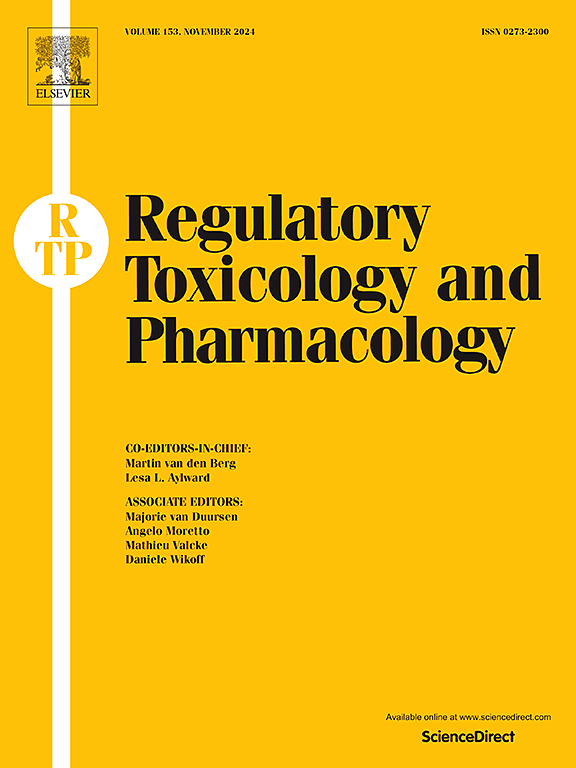抗氧化剂、氮氧化物抑制剂(DPI)和抗凋亡途径对急性磷化铝中毒大鼠碳水化合物代谢和肝功能的影响
IF 3.5
4区 医学
Q1 MEDICINE, LEGAL
引用次数: 0
摘要
磷化铝(AlP)被广泛用于自杀企图。我们评估了二苯碘(DPI)、N- N-乙酰半胱氨酸(NAC)和尼沃桑治疗对AlP毒性的影响。30只大鼠分为5组:对照组(生理盐水);其余组给予口服AlP和治疗(NAC、DPI和Nivocasan)。评估肝功能测试(LFTs)、血清和肝脏氧化标志物、胰岛素、葡萄糖、肿瘤坏死因子-α (TNF-α)、血清和胰岛白细胞介素1β (IL-1β)以及胰岛分离后葡萄糖刺激的胰岛素分泌。AlP中毒动物LFTs显著升高,NAC、DPI和Nivocasan降低至接近控制水平(P <;0.05)。DPI和nivoasan均可恢复alp诱导的低血糖。AlP组血浆过氧化氢酶、GPx和MDA升高,NAC、DPI和Nivocasan具有保护作用(P <;0.05)。DPI显著降低血清TNF-α, NAC显著降低血清IL-1β水平。NAC逆转alp诱导的胰岛素分泌降低(P <;0.05)。磷化铝(AlP)可引起低血糖和肝损害。alp相关性低血糖与炎症和氧化应激标志物升高以及胰岛胰岛素分泌受损有关,NAC可改善这种情况。DPI和nivoasan治疗低血糖。DPI和NAC均能有效降低炎症标志物。本文章由计算机程序翻译,如有差异,请以英文原文为准。
Effects of anti-oxidants, NOX inhibitor (DPI), and anti-apoptotic pathways on carbohydrate metabolism and liver function in acute aluminum phosphide toxicity exposed rats
Aluminum phosphide (AlP) is widely used in suicide attempts. We evaluated the effects of Diphenylene iodonium (DPI), N- N-acetyl cysteine (NAC), and Nivocasan therapeutics on AlP toxicity. Thirty rats were kept in five groups: control (receiving normal saline); the remaining groups were exposed to oral AlP, and treatments (NAC, DPI, and Nivocasan). Liver function tests (LFTs), serum and liver oxidative markers, insulin, glucose, tumor necrosis factor−α (TNF-α), serum and islets interleukin 1β (IL-1β), and glucose-stimulated insulin secretion through islet isolation were assessed. LFTs significantly increased in AlP poisoned animals, and NAC, DPI, and Nivocasan decreased their levels to near control (P < 0.05). DPI and Nivocasan recovered AlP-induced hypoglycemia. Plasma catalase, GPx, and MDA increased in the AlP group, and NAC, DPI, and Nivocasan had protective effects (P < 0.05). DPI significantly decreased serum TNF-α, and NAC decreased IL-1β levels. NAC reversed AlP-induced lower insulin secretion (P < 0.05). Aluminum phosphide (AlP) induces hypoglycemia and liver damage. AlP-related hypoglycemia is associated with elevated inflammatory and oxidative stress markers and impaired insulin secretion from pancreatic islets which improved by NAC. DPI and Nivocasan treat hypoglycemia. DPI and NAC were effective in reducing inflammatory markers.
求助全文
通过发布文献求助,成功后即可免费获取论文全文。
去求助
来源期刊
CiteScore
6.70
自引率
8.80%
发文量
147
审稿时长
58 days
期刊介绍:
Regulatory Toxicology and Pharmacology publishes peer reviewed articles that involve the generation, evaluation, and interpretation of experimental animal and human data that are of direct importance and relevance for regulatory authorities with respect to toxicological and pharmacological regulations in society. All peer-reviewed articles that are published should be devoted to improve the protection of human health and environment. Reviews and discussions are welcomed that address legal and/or regulatory decisions with respect to risk assessment and management of toxicological and pharmacological compounds on a scientific basis. It addresses an international readership of scientists, risk assessors and managers, and other professionals active in the field of human and environmental health.
Types of peer-reviewed articles published:
-Original research articles of relevance for regulatory aspects covering aspects including, but not limited to:
1.Factors influencing human sensitivity
2.Exposure science related to risk assessment
3.Alternative toxicological test methods
4.Frameworks for evaluation and integration of data in regulatory evaluations
5.Harmonization across regulatory agencies
6.Read-across methods and evaluations
-Contemporary Reviews on policy related Research issues
-Letters to the Editor
-Guest Editorials (by Invitation)

 求助内容:
求助内容: 应助结果提醒方式:
应助结果提醒方式:


